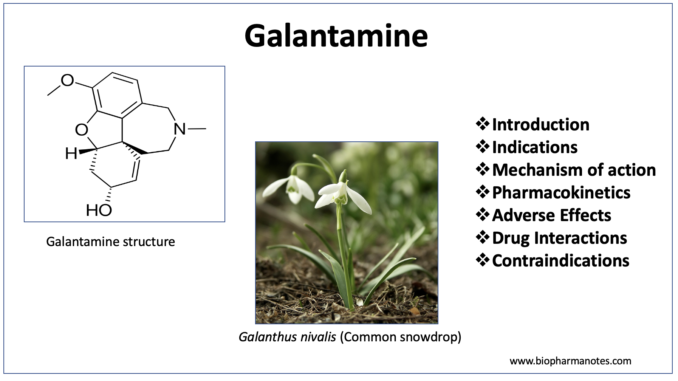
- Galantamine is oral acetylcholinesterase (AChE) inhibitor. Acetylcholinesterase is enzyme involved in hydrolysis of acetylcholine.
- Galantamine belongs to isoquinoline alkaloid family. It was discovered and isolated for first time in 1950s from bulb of plants Galanthus nivalis (common snowdrop) and Galanthus woronowii (Caucasian snowdrop). alantamine an also be isolated from bulbs of several other plants belonging to Amaryllidaceae family.
- It got FDA approval in 2001 for its use in Alzheimer’s disease. Nowadays it is also produced synthetically.
Indications of galantamine
- Used to treat mild to moderate dementia associated with Alzheimer’s disease.
- Used in memory impairment.
Mechanism of action of galantamine

Figure- Mechanism of action of galantamine (Source- Lilienfeld S, 2002)
- It has a unique and dual mechanism of action. Its two actions are competitive and reversible inhibition of acetylcholinesterase enzyme and allosteric modulation of nicotinic acetylcholine receptors (nAChRs).
- Alzheimer’s disease (AD) is a progressive neurodegenerative disorder resulting in progressive cognitive impairment and loss of short-term memory. Degeneration of cholinergic neurons have been implicated in pathogenesis of AD. Cholinergic system plays important role in memory and other important functions including learning, attention, stress response and sensory information. The degeneration of cholinergic neurons plays major role in memory loss in AD patients. Acetylcholinesterase rapidly hydrolyzes acetylcholine to choline and acetate in synaptic cleft. Some studies had also suggested the potential role of AChE in formation of amyloid fibrils which are the major characteristic feature involved in pathogenesis of AD.
- Galantamine binds to choline binding site and acyl- binding pocket of the enzyme AChE active site and lead to competitive and reversible inhibition of AChE in CNS. It mainly inhibits AChE in frontal cortex and hippocampal regions.
- Nicotinic acetylcholine receptors (nAChRs) are cholinergic receptors which are mostly expressed at presynaptic neuronal membrane. Acetylcholine binds with nAChRs to produce certain range of cholinergic actions. nAChRs are also involved in controlling release of neurotransmitters like acetylcholine, glutamate, GABA, dopamine etc. Certain studies have suggested that expression and activity of nAChRs are reduced in AD patients which may be the reason for decreased cholinergic activity.
- Galantamine binds to allosteric site of nAChR, cause confirmational change increase response of nAChRs to available acetylcholine.
- Hence, the overall effect of its dual mechanism of action is amelioration of behavioral symptoms in AD patients.
Pharmacokinetics of galantamine
- It is orally administered and undergoes rapid absorption. Available forms are tablets, solutions, or capsules. It has relatively short half-life and high bioavailability. It reaches to peak plasma concentration rapidly.
- The protein binding property is less (around 11%). Extensively metabolism occurs in liver by cytochrome P450 enzymes CYP2D6 and CYP3A4. Its major metabolites are norgalantamine, epigalanatamine, galataminone, O-desmethyl-galantamine and O-desmethyl-norgalantamine.
- It is excreted mainly by renal route in the form of urine.
Adverse Effects
- It has a good tolerability profile. Its adverse effects is mainly due to cholinomimetic mechanism of action. Common side effects include nausea, vomiting, diarrhea, dizziness, fatigue, and dyspepsia.
- Overdose may cause cholinergic crisis including severe nausea, vomiting, urination, lacrimation, salivation, hypotension, bradycardia, respiratory depression and collapse. These effects can be reversed by using atropine and supportive treatment.
Drug Interactions
- Concurrent administration of galantamine with drugs that inhibit CYP2D6 or CYP3A4 enzymes like paroxetine, erythromycin or ketoconazole may increase cholinergic effects of galantamine and increase cholinergic side effects. Hence, the dosage of galantamine should be reduced when using with these drugs.
Contraindications
- Its use is not recommended in patients with hepatic or renal impairment.
- Contraindicated in patients with known hypersensitivity to galantamine.
References
- https://go.drugbank.com/drugs/DB00674
- Lilienfeld S. Galantamine — a Novel Cholinergic Drug with a Unique Dual Mode of Action for the Treatment of Patients with Alzheimer’s Disease. CNS Drug Reviews. 2002; 8(2): 159-176.
- Kim JK et al. Pharmacological aspects of galantamine for the treatment of Alzheimer’s disease. EXCLI J. 2017; 16: 35–39.
- Perry GPVG. Alzheimer’s Disease Pharmacology. Reference Module in Biomedical Sciences 2021.
- A Textbook of Clinical Pharmacology and Therapeutics. 5th edition.
- Lippincott’s Illustrated Reviews Pharmacology. 6th edition.